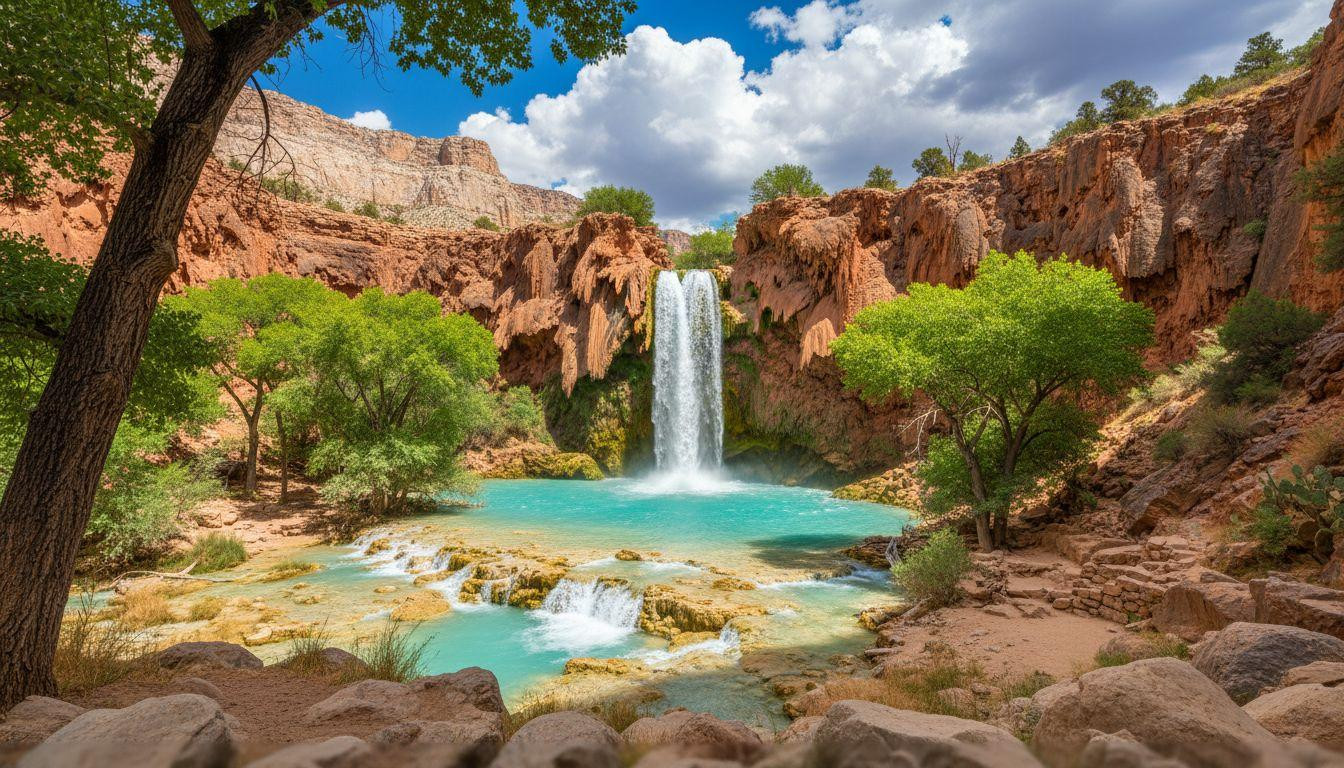Deep within Arizona’s Havasupai Reservation, turquoise water cascades 100 feet over red canyon walls. This isn’t just another waterfall photo opportunity. Havasu Falls sits behind one of America’s most competitive permit lotteries, where $455 secures three nights in a landscape that feels borrowed from another planet.
The Havasupai Tribe releases just 8,000 annual permits for over 50,000 applicants. These numbers tell a story of preservation through scarcity, where difficult access protects fragile beauty from Instagram destruction.
The permit system that protects paradise
Havasu Falls operates under tribal sovereignty, not federal park rules. The Havasupai people have managed these waters for over 800 years. Their modern permit system launched in 2010 after unrestricted access brought environmental damage.
Today’s process begins December 16, 2025, with presale applications opening at 8am Arizona time. General public sales follow February 1, 2026. The tribe’s website crashes annually from demand. Creating your HavasupaiReservations.com account months early becomes essential preparation.
Permits cost $455 per person for camping or $2,277 per room for lodge stays. Both require three-night minimums. Day hiking remains forbidden. This isn’t casual tourism but earned wilderness access.
What the 10-mile hike delivers
The trail descends 2,500 feet through exposed desert before reaching Supai Village. Pack mules carry supplies to this roadless community of 208 residents. Modern helicopters supplement traditional transport methods.
Beyond the village, the landscape transforms. Cottonwood trees shade flowing water. The first glimpse of Havasu Falls stops hikers mid-stride. Mineral-rich water creates that impossible blue-green color through calcium carbonate dissolved from limestone bedrock.
Planning your 2026 application
Success requires strategic preparation. The presale lottery accepts three preferred dates. Payment occurs manually by January 24, 2026, unlike previous automatic systems. Grand Canyon’s hidden North Rim offers alternative canyon experiences while waiting for Havasupai permits.
Cancelled permits appear daily at 8am Arizona time. Flexible travelers with desert proximity find unexpected opportunities throughout the season.
Beyond Havasu: five more turquoise guardians
The Southwest hides additional canyon waterfalls protected by permits, distance, or difficulty. Each offers different trade-offs between accessibility and preservation.
Mooney Falls: the 196-foot technical descent
Located within the same Havasupai permit area, Mooney Falls requires chains and ladders for access. Four metal ladders descend 210 vertical feet along canyon walls. Tribal inspections maintain safety equipment quarterly, with October 2024 repairs ensuring current stability.
The additional hour hike from Havasu campground eliminates casual visitors. Children under 12 face restrictions due to technical exposure. Craters of the Moon’s volcanic landscape provides similar geological drama with easier access.
Ribbon Falls: Grand Canyon’s secret garden
Grand Canyon backcountry permits protect this 101-foot cascade along the North Kaibab Trail. Acceptance rates reach 35% versus Havasu’s 15-20%. Costs remain minimal at $10 plus $8 per person nightly.
The 14-mile round trip requires two-night minimums at Roaring Springs campground. Moss-covered walls create a natural amphitheater around vivid turquoise pools measuring 20 by 30 feet with 15-foot depths.
The earned access philosophy
These permit systems represent conservation through limitation rather than exclusion. Visitor impacts decrease dramatically when access requires planning, expense, and physical commitment. The turquoise remains pristine because reaching it demands respect.
Recent visitor surveys reveal 94% satisfaction rates among permit holders. The effort invested transforms sightseeing into pilgrimage. Mount Shasta’s alpine terrain demonstrates similar wilderness ethics across California’s volcanic peaks.
Pre-permit Havasu Falls hosted over 500 daily visitors during peak seasons. Today’s 200-300 controlled access preserves both ecosystem health and visitor experience quality. The contrast speaks volumes about sustainable tourism’s future.
Thunder River and Deer Creek alternatives
Thunder River Falls emerges from Muav Limestone caves along an 18-mile trail requiring three-day commitments. Acceptance rates drop to 28% for this Grand Canyon backcountry experience. The waterfall emerges from a 100-foot cave opening, creating unique geological theater.
Deer Creek Falls demands river rafting access or extreme hiking. Colorado River permits average 12% acceptance from 3,750 annual applications. Commercial trips cost $5,500-$7,000 per person for 12-25 day adventures. Bear Lake’s mountain escape offers more accessible turquoise waters in the Rockies.
Your questions about Southwest canyon waterfalls answered
When do 2026 Havasu Falls permits become available?
Presale applications open December 16, 2025, at 8am Arizona time through January 3, 2026. Payment acceptance deadlines fall on January 24, 2026. General public sales begin February 1, 2026. Lodge reservations opened June 1, 2025, through HavasupaiLodge.com for 2026 dates.
What makes the water so turquoise at these waterfalls?
Limestone bedrock creates the distinctive color through dissolved calcium carbonate. Water percolating through ancient rock formations picks up minerals that refract light in blue-green spectrums. Temperature, mineral concentration, and depth combine to create each location’s unique hue intensity.
How do costs compare across these six waterfalls?
Havasu Falls costs $455 per person for three nights camping. Grand Canyon backcountry permits cost $10 plus $8 nightly per person. River access to Deer Creek requires $5,500-$7,000 commercial trips. Coyote Butte Falls charges just $6 for day use permits. Physical difficulty often correlates with lower permit costs.
Morning light transforms the pools into liquid gems. Canyon walls glow orange while water shimmers impossible blue. These moments justify every permit application, every training hike, every early morning start. The turquoise waits for those who earn it.
